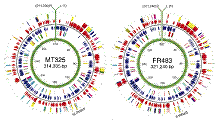Virology, Nebraska Center for
Document Type
Article
Date of this Version
1-2007
Abstract
Following acute infection, bovine herpesvirus 1 establishes latency in sensory neurons of trigeminal ganglia (TG). Reactivation from latency occurs periodically, resulting in the shedding of infectious virus. The latency-related (LR) RNA is abundantly expressed in TG of latently infected calves, and the expression of LR proteins is necessary for dexamethasone-induced reactivation from latency. Previously published studies also identified an alternatively spliced LR transcript which is abundantly expressed in TG at 7 days after infection and has the potential to encode a novel LR fusion protein. Seven days after infection is when extensive viral gene expression is extinguished in TG and latency is established, suggesting that LR gene products influence the establishment of latency. In this study, we used a bacterial two-hybrid assay to identify cellular proteins that interact with the novel LR fusion protein. The LR fusion protein interacts with two proteins that can induce apoptosis (Bid and Cdc42) and with CCAAT enhancer binding protein alpha (C/EBP- α). Additional studies confirmed that the LR fusion protein interacts with human or insect C/EBP- α. C/EBP- α protein expression is induced in TG neurons of infected calves and after dexamethasone-induced reactivation from latency. Wildtype C/EBP- α, but not a DNA binding mutant of C/EBP-α, enhances plaque formation in bovine cells. We hypothesize that interactions between the LR fusion protein and C/EBP-α promote the establishment of latency.



Comments
Published in JOURNAL OF VIROLOGY, Jan. 2007, p. 59–67 Vol. 81, No. 1 0022-538X/07/$08.00+0 doi:10.1128/JVI.01171-06 Copyright © 2007, American Society for Microbiology. Used by permission.